美索不达米亚文明 Mesopotamia
美索不达米亚的落日
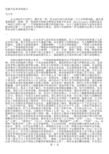
马小军
公元2003年3月20日,像往常一样,经天而行的太阳劳碌一天之后砰然西坠。就在夜幕降临的一刹那,第一枚战斧式巡航导弹划过美索不达米亚(Mesopotamia,希腊语意为“两河之间的土地”)平原晚霞尚未燃尽的美丽天际,击中了底格里斯河与幼发拉底河脉动的心脏——古老而伟大的城市巴格达。美国与其盎格鲁-萨克逊盟友运筹已久的对伊拉克的大规模战争打响了。
一
有史以来,这就是一片由光荣与悲壮的史诗铺就的,在八千年的时间里积累了太多记忆的土地。那太多的记忆令人迷惑不解:众多暴君与英雄的姓氏、令人陶醉的神话般的城市、无数令人震悚的战争、杀戮和牺牲、“人类文明的摇篮”、“种族与民族的熔炉”、“基督教的发祥地”、“穆斯林伟绩的策源地”,还有巴比伦、空中花园、让我们的童年充满无限幻想的《天方夜谭》。与传奇、光荣、辉煌、梦想、背叛、野蛮和神圣相伴随的历史,给人类留下的已足够多了,而永远不变的却只有日夜流淌的底格里斯河和幼发拉底河及其冲积而就的那片沃土,那滚烫的无尽黄沙和山岭上那不屈的峰峦。
文化的力量是深厚的。苏美尔文化中丰富多彩的史诗主题,已通过阿卡德语பைடு நூலகம்精练成经典。由十二块泥版组成的长篇巨著《吉尔伽美什史诗》,堪称人类史诗之母。它以独特的叙事方式讲述了乌鲁克英雄吉尔伽美什经历的战争和寻找不死仙草的故事。引人注目的是,史诗中记述了一场大洪水,那是神惩罚人类的举动。其中夹杂着方舟搁浅和放飞鸽子寻找陆地的情节,与《圣经》中创世纪的神话几乎完全一致。考古学家后来在美索不达米亚南部的乌尔城遗址处发现了洪水的冲积层,证实了《圣经》中地球大洪水的传说起源于乌尔。阿卡德人建立起了一个领土辽阔的楔形文字帝国。哪里讲阿卡德语,这些诗篇就在哪里流传,而当时阿卡德语已成为包括古埃及帝国在内的地中海东部国家国际关系中的通用语言。此时,与苏美尔文明比肩而立的是法老埃及文明,他们在这一比邻地区把灿烂的文明延续了两千年之久。在古埃及政府的档案馆中,书记官们就使用带有苏美尔特征的阿卡德语言在泥版上进行书写。在那个时代里,苏美尔—阿卡德语言文化的优势,堪与古埃及军事政治的优势相媲美。在此期间,这两大文明以其巨大的辐射力,向地中海、印度河,乃至于欧亚大陆腹地,播散着文明的火种。
美索不达米亚文明与伊拉克.ppt.Convertor
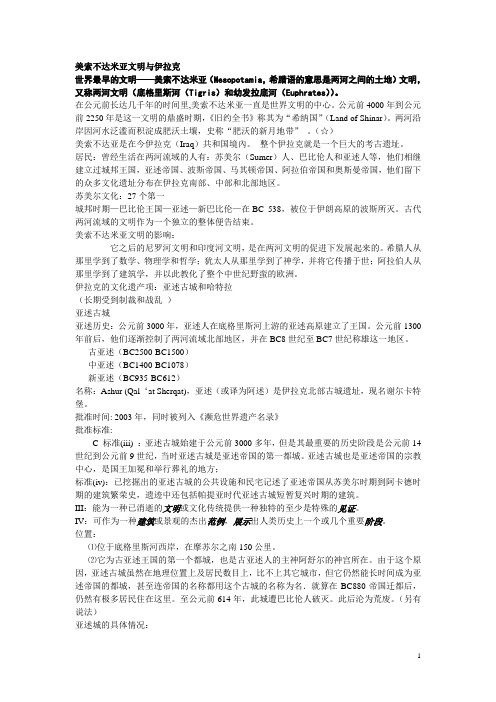
美索不达米亚文明与伊拉克世界最早的文明──美索不达米亚(Mesopotamia,希腊语的意思是两河之间的土地)文明,又称两河文明(底格里斯河(Tigris)和幼发拉底河(Euphrates))。
在公元前长达几千年的时间里,美索不达米亚一直是世界文明的中心。
公元前4000年到公元前2250年是这一文明的鼎盛时期,《旧约全书》称其为“希纳国”(Land of Shinar)。
两河沿岸因河水泛滥而积淀成肥沃土壤,史称“肥沃的新月地带”。
(☆)美索不达亚是在今伊拉克(Iraq)共和国境內。
整个伊拉克就是一个巨大的考古遗址。
居民:曾经生活在两河流域的人有:苏美尔(Sumer)人、巴比伦人和亚述人等,他们相继建立过城邦王国,亚述帝国、波斯帝国、马其顿帝国、阿拉伯帝国和奥斯曼帝国,他们留下的众多文化遗址分布在伊拉克南部、中部和北部地区。
苏美尔文化:27个第一城邦时期—巴比伦王国—亚述—新巴比伦—在BC 538,被位于伊朗高原的波斯所灭。
古代两河流域的文明作为一个独立的整体便告结束。
美索不达米亚文明的影响:它之后的尼罗河文明和印度河文明,是在两河文明的促进下发展起来的。
希腊人从那里学到了数学、物理学和哲学;犹太人从那里学到了神学,并将它传播于世;阿拉伯人从那里学到了建筑学,并以此教化了整个中世纪野蛮的欧洲。
伊拉克的文化遗产项:亚述古城和哈特拉(长期受到制裁和战乱)亚述古城亚述历史:公元前3000年,亚述人在底格里斯河上游的亚述高原建立了王国。
公元前1300年前后,他们逐渐控制了两河流域北部地区,并在BC8世纪至BC7世纪称雄这一地区。
古亚述(BC2500-BC1500)中亚述(BC1400-BC1078)新亚述(BC935-BC612)名称:Ashur (Qal‘at Sherqat),亚述(或译为阿述)是伊拉克北部古城遗址,现名谢尔卡特堡。
批准时间: 2003年,同时被列入《濒危世界遗产名录》批准标准:C 标准(iii) :亚述古城始建于公元前3000多年,但是其最重要的历史阶段是公元前14世纪到公元前9世纪,当时亚述古城是亚述帝国的第一都城。
数学史部分2古巴比伦的数学
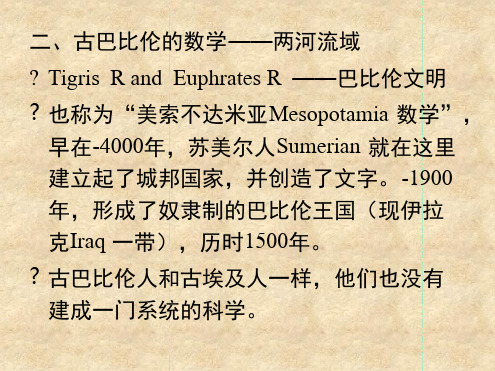
? Tigris R and Euphrates R ——巴比伦文明 ? 也称为“美索不达米亚Mesopotamia 数学”,
早在-4000年,苏美尔人Sumerian 就在这里 建立起了城邦国家,并创造了文字。-1900 年,形成了奴隶制的巴比伦王国(现伊拉 克Iraq 一带),历时1500年。 ? 古巴比伦人和古埃及人一样,他们也没有 建成一门系统的科学。
1,4,9,16,25,36,49,1×4,1×21,...,58×1 这个问题只有在60进位计数中才能得到妥善的
解释. ? 因为当时尚未引入零以及小数点,所以这种
计数法存在许多不确切之处。 如何表示 零?——用留空位的方法。
(3)分数—以常数 60,602,603... 为分母.但 无分数的记号,与表示整数的记号混合使用.
(真值为1.414)
1 ? 17 ? 0.7083 (真值为0.7071)
2 24
a2 ? b ? a ? b 2a
将其平方后,其结果总比原数大.到了希腊 时期,著名数学家阿基米德(Archimedes )、 海伦(Heron )创造出了平方后比原数小的近 似公式.
3、古巴比伦的代数algebra知识:
? 书写材料——泥板 Tablets
? 用断面呈三角形的 笔泥板上刻出楔形 的痕迹―楔形文字 Cuneiform. 已发掘 的50万块泥板中,有 400块是数学泥板.
1、古巴比伦的计数法Sccale和六十进位制:
(1)计数法:用二种基本形状表示所有的数
1
10
古巴比伦计数表
25
(2)巴比伦数学的特点——60进位制60 system ? 在1854年发现的两块泥板中有一列数:
古代美索不达米亚文明的起源和发展

古代美索不达米亚文明的起源和发展古代美索不达米亚文明起源和发展美索不达米亚文明,是指位于今天的伊拉克和以色列地区,约在公元前4000年左右出现的古文明。
它被认为是世界上最早的文明之一,其起源可以追溯到新石器时代。
美索不达米亚文明的起源和发展,一直是人类历史学界所关注和探究的话题。
一、古代美索不达米亚文明的起源古代美索不达米亚地区是美索不达米亚平原,其地理位置非常独特。
它位于两条河流之间,即幼发拉底河和底格里斯河之间。
这两条大河的汇流围绕出了美索不达米亚平原,为该地区赋予了得天独厚的地理环境。
在这个区域内,土壤肥沃、养分丰富,浇灌河水十分充足,使得农业得以大力发展,这为美索不达米亚文明的诞生提供了良好条件。
除此之外,美索不达米亚文明的诞生和发展也与当地的气候环境有着密不可分的联系。
美索不达米亚地区气候炎热干燥,缺乏自然资源。
这迫使当地人不得不依靠流经平原的幼发拉底和底格里斯两河进行农业生产,因此他们快速地开始了对这两条河流的控制和利用。
二、美索不达米亚文明的发展在公元前4000年左右,美索不达米亚地区的人民开始了灌溉和排水系统的开发。
他们筑起了一种称作“塔斯提”(ziggurat)的大型建筑,用于清理水源,堤防河岸,防止河水泛滥,从而使土地变得更为肥沃。
这些建筑物不仅起到了灌溉排水的作用,还成为了天文观测塔、宗教和政治领袖办公室以及政治宣传场所。
从公元前3000年左右开始,美索不达米亚地区进入了城市文明阶段。
当时的人们孕育了业主、奴隶、官僚层和工匠等不同的职业界别,也开始了文字的记载。
当时的美索不达米亚地区被分成了许多城邦,人们互相之间进行着贸易和文化的交流。
在城市文明阶段后,美索不达米亚地区又逐步进入了国家城邦文明时期。
从公元前2400年左右开始,古代巴比伦帝国开始崛起,它是古代世界最为庞大和强大的帝国之一,长达17个世纪时间。
巴比伦帝国的统治范围覆盖了今天的伊朗、土耳其等地,帝国的政治、经济和文化影响持续了数千年,成为了世界历史上不可忽视的一部分。
Mesopotamia
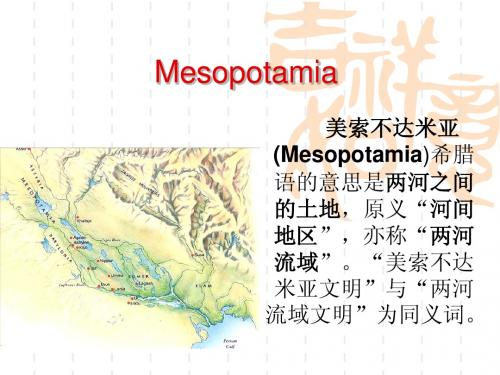
国家更替
国家名称 时间起讫 公元前3500年—前3100年 约公元前2371年—前23世纪 下半叶 约公元前2113年—前2006年 约公元前1894年—前17,16世 纪之交 建立者 苏美尔人 阿卡德人
苏美尔城邦国家
阿卡德王国
乌尔第三王朝
苏美尔人
阿摩利人
古巴比伦王国
亚述帝国 新巴比伦王国
公元前7世纪—前605年
公元前626年—前538年
亚述人 迦勒底人
两河流域文明
世界最早的文明之一──美索不达米亚文明(又称两河文明) 发源于底格里斯河(Tigris)和幼发拉底河(Euphrates)之间的流域 ──苏美尔(Sumer)地区(中下游地区)。美索不达米亚是古巴比 伦(Babylon)的所在,在今伊拉克(Iraq)共和国境内。 美索不达米亚地区在远古时期居住着许多种族,是个干旱区域, 但下游土地肥沃,所以很早就发展了灌溉网络,形成以许多城市为中 心的农业社会。两河文明的中心大概在现在的伊拉克首都巴格达一带, 北部古称亚述,南部为巴比伦尼亚。而巴比伦尼亚北部叫阿卡德,南 部为苏美尔。 美索不达米亚文明主要包括苏美尔,阿卡德,巴比伦,亚述,赫 梯等文明
Байду номын сангаас 文明成就
尼罗河文明和印度河文明,是在两河文明的促进下发 展起来的。希腊人从那里学到了数学、物理学和哲学; 犹太人从那里学到了神学,并将它传播于世;阿拉伯 人从那里学到了建筑学,并以此教化了中世纪时整个 野蛮的欧洲。
天文历法
两河文明的历法很有特色。在苏美尔阿卡德时代,制定了太 阴历,以月亮的阴晴圆缺作为计时标准,定每个月29或30天, 12个月为1年(6个月为29天,6个月为30天),每年354天,并 发明闰月,通过置闰月的办法调整。开始依靠经验置闰,后来 先后有8年3闰和27年10闰的规定。把一小时分成60分。在亚述 时期,确定了今天星期的名称和7天1周的规定。 在天文学方面,已经能够区别恒星和五大行星,还观察到 黄道。
两河流域文明汇总

苏美尔人是最先进入美索不达米亚平原的古代民族, 因为他们是来自远方的黑发种族,在他们带来的石碑上 的铭文中,自称为“黑头”。自从来到这个堆积着两条 大河携带来的肥沃泥土的三角洲上重新立国,苏美尔人 就发现既没有故土那样的石头存在,也没有埃及那样的 纸草生长,于是便发明了这样的书写方式:将软泥做成 泥版,然后进行书写,书写完毕以后烤干,以便文书的 保管。
当过度的积水渗入地下水时,含盐的水位就会上升,在土壤的毛细管
作用帮助下侵入地表层,使土壤盐碱化。从苏美尔城吉尔苏的遗址中,
法国考古队发现了从苏美尔城邦争霸时期(约公元前2400年)到乌尔 第三王朝末(前2004年)的大批农业泥板文书。这400年中的文献告诉 我们,从文明一开始,随古代灌溉农业而来的土地盐化问题就一直困
最早的美索不达米亚文明的伟大创建者——苏美尔人, 似乎既不是印欧人的一支,也不是闪米特人的一支,这一 点很可奇怪。他们的语言与汉语相似,这说明他们的原籍 可能是东方某地。但不管怎样,是苏美尔人在美索不达米 亚南部开掘沟渠,依靠复杂的灌溉网,成功地利用了底格 里斯河和幼发拉底河的湍急的河水,从而创建了第一个文 明。
南伊拉克(苏美尔)的土壤是肥沃的冲积粘土,宜于谷物种植。 但气候干旱少雨,灌溉农业为主要生产方式。然而,土壤和河水中都 含有可交换的钠离子和盐。通常,钠离子和盐被水带到地下水层中, 只要地下水位与地表层保持一定的正常距离,含钠和盐的地下水就不 能危害农田。古苏美尔人只知浇灌而不知土壤中的盐分必须用充足的 水加以过滤,并完全排泄出去,结果是当地地下水层的盐分逐年加重。
美索不达米亚文化中的领袖象征与宗教信仰

美索不达米亚文化中的领袖象征与宗教信仰美索不达米亚(Mesopotamia)古文明是世界上最早的文明之一,位于今天的伊拉克和叙利亚地区。
在这片土地上诞生了许多古老的文化和宗教信仰。
古代美索不达米亚地区的文化、政治和宗教信仰的发展是紧密相连的。
在美索不达米亚文化中,领袖象征和宗教信仰被视为人类与神之间联系的媒介,成为支撑这个文化的两个重要支柱。
本文将探讨美索不达米亚文化中的领袖象征与宗教信仰。
一、领袖象征在美索不达米亚地区,领袖意味着权力、地位和权威。
古代的美索不达米亚城邦有一个统治者,他们在政治和宗教方面都扮演着重要角色。
在古代,城邦的领袖往往是城门的守卫者,他们要保持城市的安全,管理城市的财富和资源。
在神权政治的环境中,领袖还扮演着司法、祭司和神权角色。
一个成功的领袖需要得到人民的信任和尊重,同时也需要得到神的祝福。
古代美索不达米亚的领袖往往用各种象征物来展示他们的权威和地位。
在苏美城邦,领袖会戴上特殊的头冠。
头冠上会刻有象征他们权力的图案,例如羊角、龙或太阳。
在新巴比伦城国,国王会佩戴来自世界各地的名贵玉石,证明他们的统治地位。
在阿卡德王朝时期,领袖还会使用标记印章来证明掌握资源和对区域的控制权。
尽管不同领袖使用的象征物可能不同,但都传达了同样的信息:领袖拥有权力和神的支持。
二、宗教信仰美索不达米亚文化中的宗教信仰和领袖象征相辅相成。
在古代,人们认为神灵影响着世界上的一切。
因此,与神的关系和神职人员的角色非常重要。
美索不达米亚文化中的主要宗教信仰是多神教。
这意味着人们崇拜众多的神灵,在他们中间分配神的任务和责任。
美索不达米亚的神有些形象化,例如翅膀或牛头人身等,有些是无形的,人们无法看到它们的形态。
神灵经常与自然和自然现象联系在一起,例如河流、大地和气象。
在美索不达米亚文化中,宗教信仰与领袖象征密切相关。
领袖扮演着对神的表现,在很多情况下,被认为是神的化身。
例如,在苏美文明中,国王往往被认为是城市的主神,他是神权的代言人,同时也是祭司。
两河流域文明

两河流域古文明灭绝的原因是复杂的。一方面,外部的新兴文明 如希腊和伊斯兰文明的征服和取代是重要的原因。另一方面,过度的 农业开发恶化了先天不足的生态环境也是一个主要的内因。1982年, 美国著名亚述学家雅各布森在《古代的盐化地和灌溉农业》一书中论 述了两河流域南部苏美尔地区灌溉农业和土地盐化的关系,并指出这 是苏美尔人过早退出历史舞台的重要原因。
南伊拉克(苏美尔)的土壤是肥沃的冲积粘土,宜于谷物种植。 但气候干旱少雨,灌溉农业为主要生产方式。然而,土壤和河水中都 含有可交换的钠离子和盐。通常,钠离子和盐被水带到地下水层中, 只要地下水位与地表层保持一定的正常距离,含钠和盐的地下水就不 能危害农田。古苏美尔人只知浇灌而不知土壤中的盐分必须用充足的 水加以过滤,并完全排泄出去,结果是当地地下水层的盐分逐年加重。
巴比伦空中花园,是古代世界七大奇迹之一,又称悬园。 巴比伦空中花园 在前6世纪由新巴比伦王国的尼布甲尼撒二世 (Nebuchadnezzar)在巴比伦城为其患思乡病的王妃安美依迪 丝(Amyitis)修建的。现已不存。空中花园据说采用立体造园 手法,将花园放在四层平台之上,由沥青及砖块建成,平台由 25米高的柱子支撑,并且有灌溉系统,奴隶不停地推动连系著 齿轮的把手。园中种植各种花草树木,远看犹如花园悬在半空 中。巴比伦文献中,空中花园仅是一个谜,甚至没有一篇提及 空中花园。 千百年来,关于“空中花园”有一个美丽动人的传说。新巴比伦国王尼 布甲尼撒二世( Nebuchadnezzar II, 在位605 BC - 562 BC)娶了米底的公主 米梯斯为王后。公主美丽可人,深得国王的宠爱。可是时间一长,公主愁容 渐生。尼布甲尼撒不知何故。公主说:“我的家乡山峦叠翠,花草丛生。而 这里是一望无际的巴比伦平原,连个小山丘都找不到,我多么渴望能再见到 我们家乡的山岭和盘山小道啊!”原来公主得了思乡病。于是,尼布甲尼撒 二世令工匠按照米底山区的景色,在他的宫殿里,建造了层层叠叠的阶梯型 花园,上面栽满了奇花异草,并在园中开辟了幽静的山间小道,小道旁是潺 潺流水。工匠们还在花园中央修建了一座城楼,矗立在空中。巧夺天工的园 林景色终于博得公主的欢心。
外国文化概论复习资料

外国文化概论复习资料名词解释L “两河流域文明”:两河流域文明又称美索不达米亚文明(Mesopotamia culture),或两河文明。
是指在两河流域间的新月沃土(底格里斯河和幼发拉底河之间的美索不达米亚平原)所发展出来的文明,是西亚最早的文明。
主要市苏美尔(Sumerian).阿卡德.巴比伦、亚述等文明组成。
2. “理念论”:古希腊碎学家柏拉图的著名学说,是哲学世界的基础。
所谓“理念"是不依存物质世界而独立存在的本体,柏拉图认为现象世界的后而存在着一个理念世界,一个比R常经验到的世界更高级的世界。
理念世界是原型,现实世界是只不过是对它的模仿。
世界有三种存在方式:理念、形式和感觉。
3. “模仿的模仿”:古希腊时人们界定艺术的普遍观点。
大哲学家柏拉图认为世界的本质是理念,现实世界是对理念世界的模仿,艺术又是对现实世界的模仿,艺术的木质因而是模仿的模仿,这种模仿也就是不真实的.虚幻的。
4.“骑士精神”:骑士制度是中世纪西欧造就出的一种特殊现象,骑士既是封臣又是战士,同时还是虔诚的基督教徙,由骑士制度造就了“骑士精神”,以效忠主人、勇敢顽强、注重荣誉、保护弱者、护卫基督教、尊崇女性等为特征。
骑士精神对西方现代的绅士风度和优雅的生活方式有一定的影响。
5.“唯理论.这是17世纪法国哲学家笛卡尔的观点,笛卡尔认为一切都要用理性去判断,理性不能解决的问题宁可存疑也不能凭信仰来代替。
它的意义在于动摇了中世界碎学的思辨方法和对教会的信仰权威。
6.“我思故我在”:这是17世纪法国碎学家笛卡尔的观点,主张从怀疑一切岀发,认为唯一不能被怀疑的是正在怀疑的这件事木身,即作为一个思想主体的“我”存在这个事实是不可怀疑的,从而为正在思考和正在怀疑的主体树立了绝对的权威,是为其哲学的第一原理, 构成其整个形而上学体系的根基,开创了近代哲学的唯理论思潮。
7.“上帝死了”:这是19世纪德国碎学家尼采提出的命题,是尼采对基督教传统道德最严厉的批判。
美索不达米亚文明英文介绍
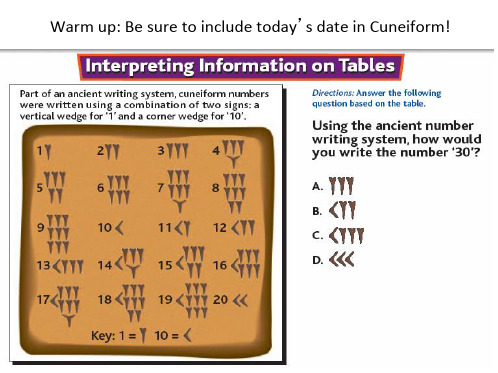
Civilization in Mesopotamia began in the valleys of the Tigris and Euphrates Rivers. Civilizations first began as villages. The villages gradually grew into complex societies.
O Recognize major historical time periods (i.e., Early Civilizations .
O Recognize the basic components of culture (i.e., language, common values, traditions, government, art, literature, lifestyles).
O Fertile Crescent was a curved strip of land that extended from the Mediterranean Sea to the Persian Gulf. The rivers in the area often flooded in the spring leaving behind rich soil for farming.
O Earliest civilization started in area between Tigris River and Euphrates River.
O This area called Mesopotamia (“land between the rivers”)
两河流域文明

两河流域文明位于中东伊拉克南部由幼发拉底河与底格里斯河形成的两河流域,古称"美索不达米亚"(Mesopotamia)。
这里诞生过人类最早的文明--公元前5千多年前的苏美尔文明,它比已知的埃及、中国、希腊、印度的文明还要早,有人说历史是从苏美尔人开始的。
苏美尔人创造过27个世界最早的发明:最早的学校、最早的车轮、最早的船、最早的文字、最早的律法……。
这里是《圣经》中所说的"伊甸园",这里曾矗立着通天的巴比伦塔,最早的史诗《吉尔伽美什》记载着地球大洪水和吉尔伽美什方舟的故事。
辉煌的古代文明诞生在这片神奇的土地,巴比伦、乌尔、尼尼微、亚述,这些曾经伟大的城市消失在这片古老的土地,战火不断燃烧在这片神奇的土地……两河流域文明发展史约公元前4000年苏美尔人定居美索不达米亚(Mesopotamia 希腊文中美索不达米亚意为"两河之间的土地")。
公元前3200年"东方的拉丁语"楔形文字在两河流域形成。
两河流域缺乏木材和石料,但有取之不尽来自两河冲积平原上的粘性泥土,苏美尔人将之制成泥版,用芦苇做成的书写工具在上面刻字或画图,形成的文字符号的每一笔按压的部分痕迹宽深,拖出的部分窄浅,就像木楔一样。
楔形文字的名称由此而来。
公元前3000年苏美尔人制定了世界上最早的天文历法。
苏美尔人在高台阶上的观象台上观察月亮的变化,根据月亮的盈亏将一年分为12个月,共354天,设闰月。
一星期七天,由天上星晨各种神的名字命名:星期天(太阳神)、星期一(月神)、星期二(火星神)、星期三(水星神)、星期四(木星神)、星期五(金星神)、星期六(土星神)。
世界上最早的学校诞生在苏美尔的尼普尔,是当时为王室和神庙培养书吏和书记员的学校。
世界上最早的史诗《吉尔伽美什》流传在两河流域,讲述乌鲁克的国王、大英雄吉尔伽美什、三分之二是神,三分之一是人,完成了许多伟大的业绩的故事。
美索不达米亚古代文明的摇篮

美索不达米亚古代文明的摇篮美索不达米亚(Mesopotamia)是古代世界上最早的文明之一,也是人类现代文明的重要起源地之一。
它位于今天的伊拉克和叙利亚交界处的两河流域地带,因为地处幼发拉底与底格里斯两条河流之间而得名。
一、文明的诞生美索不达米亚的古代文明起源于公元前3000年至公元前2000年的早期玛里(Sumer)人文化。
早期的玛里人是以城邦为单位的农业社会,他们建立了众多的城市,开展了灌溉农业并实行了分工制度。
在玛里城市中,人们开始发展书写系统,建立起法律、宗教和政治制度,形成了成熟的早期城市文明。
二、政治与社会制度美索不达米亚的政治制度主要由君主制和神权制构成。
君主制度的代表是国王,他拥有绝对的权力,被认为是由神授权的统治者。
而宗教也对政治起到了重要的影响,人们相信国王与神有着联系,并且国王的权力来自于神。
在社会结构上,美索不达米亚分为贵族、平民和奴隶三个主要阶层。
贵族是统治者及其亲属,他们享有特权和权力。
平民则包括自由公民和自耕农,他们受各种法律、规则和制约的限制。
而奴隶则是社会的最底层,被各类统治者和富有者所拥有,用于从事身体劳动。
三、经济与贸易美索不达米亚是一个农业社会,人们种植大麦、小麦、大豆、棉花等农产品,并通过灌溉系统来保证农业的生产。
此外,养殖业也十分发达,人们以牛、羊、猪等为家畜。
在贸易方面,美索不达米亚与周边文明进行了广泛的贸易往来,包括木材、石头、金属、香料等商品的交换。
在城市中,人们建立了市场,进行购买和交换,交易活动的兴盛促进了经济的发展和城市的繁荣。
四、科学与技术美索不达米亚的古代文明在科学和技术方面也取得了一系列的重要成就。
他们发明了最早的文字系统——楔形文字,并在粘土板上进行了大量的记录和记录。
这一发明极大地促进了知识的传播和文明的进步。
此外,美索不达米亚人还在冶金、建筑、农业、数学和天文学上取得了显著的成就。
他们掌握了铜制品和青铜制品的制作技术,并修建了寺庙、宫殿和城市的规划。
第2讲美索不达米亚和波斯(13)

5、宗教。宗教在两河流域民众的生活中占有很重 要的地位。
多神崇拜:天神(安努)、地神(恩利尔)、水 神(埃阿)、太阳神(沙马什)、月神(苏美尔 人称南那,阿卡德人称辛)、女神(伊什塔尔) 等。
特点:它不主张有什么极乐的和永恒的后世。由 于宗教在苏美尔中有着重要的作用,祭司在当时 社会中占据着重要的地位。祭司和管理人员(这 两个词往往意义相同)需要学习楔形文字,因而 神庙区内附设有学校,教授楔形文字和祭司等级 需要掌握的其它知识,苏美尔时期的学校是现知 人类文明史上最早的学校。
(2)、行政体制。亚述是很早实行行 省制的国家。亚述帝国时期,亚述延续 早期的一些做法,在帝国境内实行行省 制。行省长官的职权限于负责收取赋税 和组织居民执行国家义务。行省的政务 由另设的委任官治理。亚述是较早设立 “驿站”制度的国家。亚述帝国的统治 者认识到交通对于政治统一的重要性, 他们在帝国境内开辟了宽广的道路,设 立了“驿站”。国王的信使和军队可以 迅速驰往各地。
3、文字的发明。两河流域有独特的文字系统, 世界上最早的系统文字就出现在苏美尔时期 (约公元前3500年)。两河流域书写的材料是 用粘土制成的半干的泥板,笔是用芦苇杆(或 骨棒、木棒)做的,留下的字迹笔画很自然地 成了楔形,因此称为楔形文字(cuneiform)。 写好后的泥板晾干或烧干,长期保存。苏美尔 人所创造的楔形文字,经过演变,被后来的阿 卡德人、巴比伦人、亚述人所承袭,并随着商 业和文化交流的扩大而传播到整个西亚。
新巴比伦历时不到一百年就被波斯人灭亡了。
文明特征
美索不达米亚人知道人总有一死,对是不 是存在另一世界不太相信。因此只顾眼前, 对在阴间生活不抱多少希望,有较多的利 己主义追求和讲求实惠。
美索不达米亚文明重视契约和法律。
美索不达米亚 、苏美尔人、阿卡德人、巴比伦人的文学史

Mesopotamian/Sumerian/Akkadian/Babylonian LiteratureWhen we discuss the literature of the Sumerians, we must first cover the land of Mesopotamia.“Meso” is Greek for “between,” and “potamia” is Greek for rivers (think of how fresh water from a river is drinkable and, therefore, “potable.” By the way, “hippo” is Greekfor horse, so that a “hippo potamus” is a “river horse.”)Therefore, Mesopotamia means, “between rivers.”The land was the oasis situated around the Tigris and the Euphrates rivers. (Compare to the Garden of Eden, which Genesis states is the intersection of four rivers, including the Tigris and Euphrates. It is therefore likely that this land influenced the concept of Eden. The situation of the land between the Tigris and Euphrates is shown on the map below: Figure 1: Map of Mesopotamia, Showing Relationship to Mesopotamia andTigris.Of course, it was easy for migrants to settle there and found an agricultural society. The water source enriched the soil and allowed for fertile farming. The green area on the above map refers to this "Fertile Crescent,” where crops could be easily sustained. Whatever hunter-gatherer society had previously existed for these people faded away into a settled civilization, really the first Western civilization.Sumer was an important, capitol city in southern Mesopotamia. The citizens of this city developed cuneiform, a system of wedge-and-line-shaped writing characters. It is pictographic, not alphabetic:Pictographic writing represents images through a system of writing, rather than letters. So, in the image below, we see lines and wedges representing images. That is, one of those means king, another sun, and so on. However, it is not as if they are spelled out. There are no symbols that spell K-I-N-G, rather there is just an image that means the concept of king:Figure 2: Example of CuneiformLater, after the fall of Sumer, the Akkadians (early Babylonians) write down and canonize old Mesopotamian myths using this Sumerian system of writing. Once the Akkadians adopt it, however, the language is known as Assyrian.Enuma ElishThe Babylonian (Akkadian) Epic of Creation, known as the Enuma Elish, was written in cuneiform, and is based in Sumerian Mythology. Here, the mother of all creation, Tiamat, bears some unruly children. When they are nearly killed by their father, the children preemptively kill their homicidal father. This enrages Tiamat, who transforms into a terrible dragon. One of the children, Marduk slays her, tearing her in two, placing half of her body in the sky, and half on the earth. This seems to represent the splitting of waters into the oceans and the sky. Also, it seems to represent the establishment oforder over the chaos symbolized by Tiamat. Marduk becomes king of the gods and orders the rest of creation. While this story is earlier than the Biblical Account ofCreation in The Book of Genesis, it does have some parallels that we will discuss later.Its genre (or type of literature) is creation epic:Creation Epic: A lengthy, narrative poem, ordinarily concerning a serious subjectcontaining details of heroic deeds and events significant to a culture or nation.Date: Circa 1800 BCE perhaps earlierAlso it is a Chaoskampf:“The motif (repeated cultural element in literature) of Chaoskampf (German for "struggle against chaos") is ubiquitous in myth and legend, depicting a battle of a culture hero deity with a chaos monster” </wiki/Chaoskampf - Chaoskampf>:Figure 3: Marduk vs. TiamatSo, in this battle in the Enuma Elish, we see themes of order vs. chaos, kingship, succession, familial strife and so on, that we will see in other works we study.The Epic of GilgameshThe Epic of Gilgamesh is a heroic epic from about 1800 BCE. Gilgamesh was likely a real person, and the historical King Gilgamesh probably ruled in about 2700 BCE. The work is a heroic epic:o Heroic Epic:a lengthy narrative poem, ordinarily concerning a serioussubject containing details of heroic deeds and events significant to aculture or nation.o The later half of the epic deals with a deluge myth—a myth concerning the events of a worldwide flood. In addition to this portion of the textthat relates the flood secondhand, Babylonian culture has the oldestdeluge myth, the Atra-Hasis, </wiki/Atra-Hasis>.o In short, the gods become upset at humans and attempt to wipe them out through a worldwide flood. This occurrence predates the action ofGilgamesh.The primary theme (universal concept explored in a work) of Gilgamesh is mortality—the fear of death as well as the acceptance of it.Other themes include:•Love-often homoerotic•Inward Growth•Journey, and life as an inevitable journey toward deathHebrew Scriptures (The Torah or Old Testament)/ Genesis andJobTorah•Date: Babylonian Captivity (Circa 589 BCE)•Language: Hebrew•Genre: National Epic•The Torah, called the Pentateuch in the Christian tradition, is the first five books of the Hebrew scriptures, attributed to Moses.•In 589 BCE, the Hebrews were conquered and brought into Babylonian captivity.•While many of sacred Hebrew stories existed prior to Babylonian captivity, the books of the Tanakh--what Christians refer to as the Old Testament--werecanonized at this time.•Many students ask, “Well, if the Hebrews were in captivity, how did they have time to make a sacred work? The answer is that this captivity was not hard, literal enslavement for all Hebrews. Some captives led relatively free lives in Babylon.Thus, some of them had time to codify a sacred text.•The close proximity to the Babylonians at the time might partially explain some of the similarities between the Old Testament and the Babylonian/Sumerianmyths.Genesis•Date: As the Torah, Circa 589 BCE•Genre: Primeval HistoryLet me just hit some high points here:•God creates the world from a verbal command, called a “fiat” (Latin for, “let there be…” as in, “let there be light.”o This is a much less violent creation than in other culture’s religions and myths. Most creation myths include a Chaoskampf of the creator fightinga monster of chaos.o Some scholars believe that some violence existed in a previous, orally transmitted, version of the Biblical creation, but that later Hebrew writersleft it out. Why leave out some conflict with a dragon; wouldn’t the storyhave been more interesting with the draconic conflict left in?o Other texts in the scriptures make passing references to “leviathan” and “Rahab,” which may have been some “chaos being” Yahweh had toconfront during creation. That is, before the whole conflicted got editedout of Genesis </wiki/Leviathan>.o Below is an engraving of this theoretical conflict by artist Gustav Dore:Figure 4: The Destruction of the Leviathan•Transition to the creation of humans, as I mentioned before, Eden is located at the intersection of the Tigris and Euphrates, inside the “Fertile Crescent.”•The serpent of the garden is not clearly identified as Satan. That identification comes later. For the development of the character of Satan, see Job.•Cain and Abel are, of course, Adam and Eve’s first children. Is their conflict an allegory for agriculturalists v. herdsmen? Hopefully, we have time to discuss this.•Most scholars think that the Tower of Babel story recollects a time when humanity was all culturally unified, and thus spoke a similar language, like Proto-Indo-European.•Most scholars think that the sacrifice of Isaac is an anti-human-sacrifice story.Other modern readers have difficulty with it. Hopefully, we have time to discussit.Job•At the outset of the story of Job, there is a court held in Heaven. Satan, whose name is Hebrew for “Adversary” arrives to “trouble-shoot” humanity in a sense.He claims that Yahweh’s righteous champion, Job, merely needs to be tested toexpose the shallowness of his faith.o So rather than being the archenemy of God, Satan here is more of a tester of human loyalty to God.o The interaction of God and the other Heavenly beings here seems similar to Babylonian and Greek stories, in which the affairs of the gods havedirect implications for mankind. In the remainder of the Hebrew scriptures,God seems to act more independently and less arbitrarily. To me, it feelsrather hollow that the suffering of Job depends on what all amounts to abet.•The Book of Job mentions a “leviathan.” This is usually interpreted to be a whale, but considering that this is a much older text, some scholars point to its being asea monster similar to Tiamat.o Again, this is the theory of omitted violence from the Hebrew creation myth that would have paralleled Tiamat v. Marduk.That concludes this lecture. Do your discussion posts, and make sure you have the assignment read before you continue.。
古代美索不达米亚文明
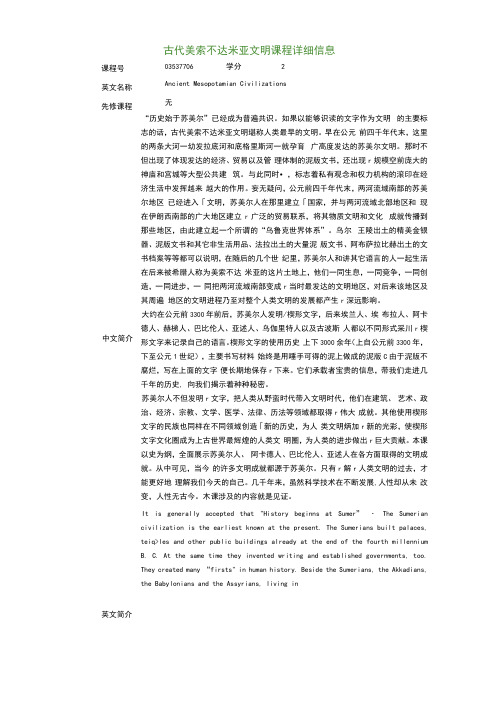
古代美索不达米亚文明课程详细信息03537706 学分 2 Ancient Mesopotamian Civilizations 无“历史始于苏美尔”已经成为普遍共识。
如果以能够识读的文字作为文明 的主要标志的话,古代美索不达米亚文明堪称人类最早的文明。
早在公元 前四千年代末,这里的两条大河一幼发拉底河和底格里斯河一就孕育 广高度发达的苏美尔文明。
那时不但出现了体现发达的经济、贸易以及管 理体制的泥版文书,还出现r 规模空前庞大的神庙和宫城等大型公共建 筑。
与此同时•,标志着私有观念和权力机构的滚印在经济生活中发挥越来 越大的作用。
妄无疑问,公元前四千年代末,两河流域南部的苏美尔地区 已经进入「文明,苏美尔人在那里建立「国家,并与两河流域北部地区和 现在伊朗西南部的广大地区建立r 广泛的贸易联系,将其物质文明和文化 成就传播到那些地区,由此建立起一个所谓的“乌鲁克世界体系”。
乌尔 王陵出土的精美金银器、泥版文书和其它非生活用品、法拉出土的大量泥 版文书、阿布萨拉比赫出土的文书档案等等都可以说明,在随后的几个世 纪里,苏美尔人和讲其它语言的人一起生活在后来被希腊人称为美索不达 米亚的这片土地上,他们一同生息,一同竞争,一同创造,一同进步,一 同把两河流域南部变成r 当时最发达的文明地区,对后来该地区及其周遍 地区的文明进程乃至对整个人类文明的发展都产生r 深远影响。
大约在公元前3300年前后,苏美尔人发明/楔形文字,后来埃兰人、埃 布拉人、阿卡德人、赫梯人、巴比伦人、亚述人、乌伽里特人以及古波斯 人都以不同形式采川r 楔形文字来记录自己的语言。
楔形文字的使用历史 上下3000余年(上自公元前3300年,下至公元1世纪),主要书写材料 始终是用唾手可得的泥上做成的泥版C 由于泥版不腐烂,写在上面的文字 便长期地保存r 下来。
它们承载者宝贵的信息,带我们走进几千年的历史, 向我们揭示着种种秘密。
苏美尔人不但发明r 文字,把人类从野蛮时代带入文明时代,他们在建筑、 艺术、政治、经济、宗教、文学、医学、法律、历法等领域都取得r 伟大 成就。
美索不达米亚文明
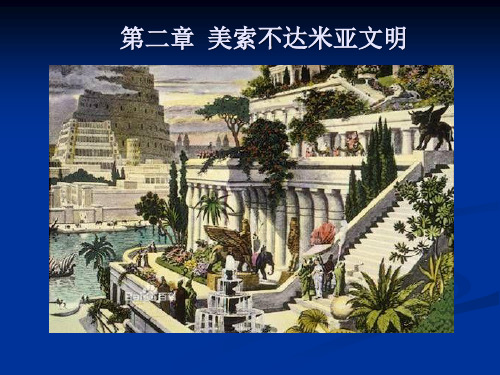
苏美尔人的宗教是一种多神崇拜,接近原始民族的万物有 灵论,凡是自然界的万物都是神性的表现。在苏美尔人大 大小小的神殿里,供奉着3000多位神灵。太阳、月亮、 雨、水、大地、空气、星辰和各种植物都是神的化身,每 座城市都有它的庇护神。
苏美尔人的宗教发生了两个转变,第一个转变是由将神灵 视为自然的一部分转变为把神灵想象为具有人格特征,这 一转变发在公元前3000纪(公元前3000年到前2000年) 。第二个转变是由赋予神灵以人格特征,转变为把神灵想 象为无所不能的主宰,各个领域都有自己的主宰,而其中 的一个神恩利尔则被视为所有这些主宰的主宰,这是朝着 神性合一和神灵万能迈进了一步。这一转变发生在公元前 3000纪末。
到公元前2320年左右,来自美索不达米亚北部的闪米特
人(也译作塞姆人,Semitic People),在其领袖萨尔贡 (意为真正的国王)一世的领导下,以阿卡德为基地,首 先征服了整个苏美尔,建立了一个从波斯湾到地中海的阿 卡德帝国。
萨 尔 贡 一 世
萨 尔 贡 一 世
阿卡德帝国
闪米特人是起源于阿拉伯半岛和叙利亚沙漠的游牧民族,
在轴心时代,各个文明都出现了伟大的精神导师——古希 腊有苏格拉底、柏拉图、亚里士多德,以色列有犹太教的 先知们,古印度有释迦摩尼,中国有孔子等。他们提出的 思想原则塑造了不同的文化传统,也一直影响着人类的生 活。更重要的是,虽然中国、印度、中东和希腊远隔千山 万水,但它们在轴心时代的文化却有很多相通的地方。
世界古代史包括上古和中古两个时期。上古是人类进入文 明并取得重要文化成就的时代,时间跨度很大,大体上涵 盖公元前四千年代苏美尔人建立国家到公元5世纪后期西 罗马帝国的灭亡这段时期。
人教部编版九年级上册第2课古代两河流域

第十五条 自由民将宫廷之奴或婢,或穆什钦努之 奴或婢,带出城门外者,应处死。 第二八二条 倘奴隶告其主人云:“你非吾之主 人”,则此主人应证实其为自己的奴隶,而后其主 人得割其耳。 奴隶制度在古巴比伦相当发达,法典
二、古巴比伦王国
《汉谟拉比头像》约 作于公元前2000年左 右的美索不达米亚
1 国王:汉谟拉比
2 策略:各个击破
3 地区:两河流域中下 游
4 制度:君主专制
5 法典:《汉谟拉比法 典》
二、古巴比伦王国
完成统一后,汉谟拉比是如何管辖他的国家的?
实
材料一:汉谟拉比拥有一套高效率的官僚体系,各种官 吏由国王本人任免。各行省和城市总督的重要职 责有:管理王室土地;对合法占有的土地给予保护, 对非法占有的土地子以没收;出租王室土地,征收 各种租税。
同学们知道这是为什么吗?
第一九六条 倘自由民 损毁任何自由民之眼, 则应毁其眼。 第一九八条 倘彼损毁 穆什钦努之眼或折断 穆什钦努之骨,则应 赔银1明那。 第二00条 倘自由民击 落与之同等之自由民 之齿,则应击落其齿。
三、《汉谟拉比法典》
材料一:
第一九九条 倘彼损毁自由民“自由民犯强盗罪 而被捕者,应处死。”
谟
拉
“倘理发师未告知
比
奴隶之主人而剃去非
法
其奴隶之奴隶标识者,
典
则此理发师应断指。”
( 摘 录
以眼还眼,以牙还 牙 An eye for an eye
And A tooth for tooth.
)
——摘自《汉谟拉比
法典》
三、《汉谟拉比法典》
Ancient Mesopotamia 古代美索不达米亚
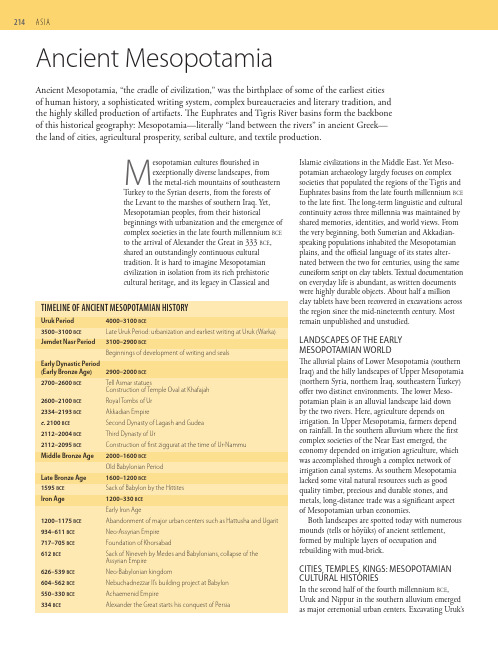
EXTENT OF MESOPOTAMIA Although situated in a hot, dry part of the world, Mesopotamia flourished because of its position between the Tigris and Euphrates Rivers—an irrigated area allowing the cultivation of grains.MESOPOTAMIAN MUSICIANS This stele depicting a group of musicians dates to the third millenniumat Tello (ancient Girsu), Iraq.The Development of Writing218 ASIAOne of the earliest writing systems of the ancient world was developed in southern Mesopotamia, approximately between 3300 and 2900 BCE . It is widely known as the cuneiform script, written with a reed stylus on soft damp clay tablets, which then either hardened up in Mesopotamia’s dry heat or, in rare cases, was baked. Th e earliest evidence of writing comes from the Late Uruk and Jemdet Nasr Period Levels IVa and III at the site of Uruk (Warka), in the Eanna Precinct (the sanctuary complex dedicated to the goddess Inanna) in the remains of a cultic/administrative building. Th ese earliest documents were composed of pictographic and numerical signs, and appear to be economic documents, testifying to the fact that writing appeared as an administrative, bureaucratic technology in the context of urbanization, increasing social and political complexity, and the appearance of monumental architecture.REVERING THE GODSThis stone stele is dedicated to Shamash, the Sumerian and Babylonian sun god. It dates to c. 860 BCE and was erected to mark the rebuilding of the temple in Assyrian times.KEEPING TALLYAmong the many testaments to everyday life found in Mesopotamia is this Sumerian clay tablet, dating to c. 2350 BCE , which lists an account of goats and sheep. It was found at Tello (ancient Girsu), one of the first sites in the region to be extensively excavated.Stratigraphically the earliest seven tabletscome from a structure called Temple C. However, approximately 6,000 tablets were excavated in the Late Uruk and Jemdet Nasr levels in the Sanctuary of Inanna at Uruk, primarily recovered from rubbish dumps or the fi lls used to create foundations for Level III buildings. Th is suggests that the practice of using written economic documents quickly spread with the passage of time. Yet the invention of cuneiform script was not a spontaneous invention of the scribes at the Eanna complex. In southern Mesopotamia, since the Neolithic and long before the appearance of tablets, hollow clay balls and clay tokens were used to record and administer economic transactions. Regularly shaped and sometimes incised small lumps of clay (tokens) were deposited in clay spheres that were hollow inside. Th e outer surfaces were then impressed with cylinder seals.WEDGE-SHAPED WRITINGCuneiform means “wedge-shaped”—the triangular tip of the stylus made small triangular signs in com-bination with lines. Th e earliest Uruk tablets, also known as “archaic” or “proto-cuneiform” tablets, present a complex system of logographic andnumerical-metrological signs. Scholars have pointed out that these logograms or pictograms draw heavily on the pictorial repertoire of representations on seals and other visual media. For instance, the reed bundle that represents Inanna in pictographic writing is also attested extensively on cylinder and stamp seal impressions and alabaster vases. Approximately 900 signs were identifi ed from this earliest phase. Th e incised iconographically explicit pictograms of theANCIENTMESOPOTAMIA219archaic tablets were gradually abstracted with the increasingly effi cient and dexterous use of the stylus and its multiple combinations of the basic cuneiform mark (a wedge and a line).COMBINING PICTURES AND NUMBERSAs the archaic tablets from Uruk are entirely picto-graphic and numerical, they can be a means of incor-porating rebus writing, phonetic/syllabic signs, and grammatical affi xes; Sumerian is attested as the lang-uage of writing in southern Mesopotamia. Among the tablets from Ur dating to around 2800 BCE, traces of Sumerian can be detected. Sumerian cannot be related to any other languages in world history. It was spoken in Mesopotamia until it was restricted to scholarly endeavor from the early second millennium BCE onward. Cuneiform script was also adopted for writingAkkadian, the commonly used Semitic language ofMesopotamian history.For both Sumerian and Akkadian, in the script’smost complex form and throughout its use in history,cuneiform signs acquired multiple values, used eitheras syllables or as ideograms that stood for a word. Th ewriting system necessitated a complex combinationof both, making the script relatively diffi cult to follow.Alphabetic writing was not introduced to Meso-potamia until the Iron Age, with Aramaic, whichdeveloped out of Phoenician in c. 900 BCE. In theIron Age in northern Syria and Anatolia, a hieroglyphicscript was used in writing monumental inscriptionsin Luwian by several regional states. Cuneiform wasadapted to write both Aramaic and Luwian.ROYAL INSCRIPTIONSThis ancient Sumerian stonegate-socket bears an inscriptionof Ur-Gur, better known as Ur-Nammu (who ruled Ur from 2112to 2095 BCE). Cuneiform scriptrecorded important politicaland historical events, as well asdaily economic transactions andactivities relating to the temples.CYLINDER SEALSCylinder seals are another ubiquitous invention of Mesopotamian societies in the context of the Late Uruk urbanization, following the more widely known stamp seals. Cylinder-shaped seals were often carved out of hard and precious stones and bore complex pictorial represen-tations (seen at right), which were impressed on clay by means of rolling. They were used to seal vessels, bundles, or doors, in addition to clay tablets or hollow clay balls. Since many of these clay elements used in transactions bear shapes and symbols that can be matched with the earliest pictograms and numerical signs in the earliest Uruk tablets, scholars have argued that they need to be seen as earlier stages in the development of the cuneiform script.。
第三讲美索不达米亚文明和波斯文明

第三讲美索不达米亚文明和波斯文明第三讲美索不达米亚文明和波斯文明一、与埃及文明的比较“美索不达米亚”(Mesopotamia)一词来自希腊语,意指“两河之间”,是指底格里斯河和幼发拉底河之间的土地。
“美索不达米亚文明“的地理范围要更宽广,它包括从波斯湾到亚美尼亚山地、从伊朗高原到叙利亚这样广袤的地区,即受到两河之间产生的那种文明同化的地区。
人们常常将埃及文明和两河流域文明相提并论,因为它们有许多相似点:这两支文明几乎一样的古老,它们都有各自的文字系统,它们都孕育于大河流域,都实行君主专制统治等。
但是细究一下,美索不达米文明在许多方面都与埃及文明不同。
不同点:1、在地理上,两河流域尽管非常肥沃(处在肥沃的“新月形沃地”的东翼),但灌溉不可或缺。
这两条河流和尼罗河不同,它们的来水量不是很有规律,底格里斯河和幼发拉底河每年四月至六月间,由于山区冰雪融化再加上不定期的大雨,随时可以暴发洪水,洪水的时间和大小都不可预测。
因此治水成为两河流域人民不可忽视的重要任务。
他们与自然的关系就成了征服自然和改造自然的关系。
另外两河流域不是像尼罗河谷那样是块相对封闭的地区,该地区易遭侵略。
在古代,两河流域分为南北两部分,北部叫亚述,南部叫巴比伦尼亚。
尼普尔以南滨临波斯湾口的地区叫苏美尔(Sumer),苏美尔地区的居民称为苏美尔人。
2、在政治上,它没有像埃及文明那样有较长时间相对稳定的发展,它的政治史曾有几次比较突然的中断,经历了多民族的变更。
文明起源于苏美尔人(约公元前3500),但千年后,被阿卡德人(公元前2340-2100)征服,稍后又获得独立。
约公元前2000,被闪米特人的一支(阿摩利特人)征服,两河流域进入古巴比伦时期。
古巴比伦帝国在约公元前1600年受到赫梯人的侵扰。
1250年被喀西特人推翻,随后落到了亚述人手里,成为亚述帝国(公元前9世纪-前7世纪)的一部分。
当亚述帝国衰落后,闪米特人的一支迦勒底人在约公元前626年建立新巴比伦国(公元前626~前538年),但新巴比伦历时不到一百年就被波斯人灭亡了。
- 1、下载文档前请自行甄别文档内容的完整性,平台不提供额外的编辑、内容补充、找答案等附加服务。
- 2、"仅部分预览"的文档,不可在线预览部分如存在完整性等问题,可反馈申请退款(可完整预览的文档不适用该条件!)。
- 3、如文档侵犯您的权益,请联系客服反馈,我们会尽快为您处理(人工客服工作时间:9:00-18:30)。
Domestication can be defined as a primitive form of genetic engineering in which certain plants and animals are brought under human control, their objectionable characteristics eliminated, their favorable ones enhanced and in the case of animals, can be induced to reproduce in captivity. --Nagle, p. 3.
The Beginnings of Writing Farmers needed to keep records. The Sumerians were very good farmers. They raised animals such as goats and cows (called livestock). Because they needed to keep records of their livestock, food, and other things, offictem of writing develops. The earliest form of writing dates back to 3300 B.C. People back then would draw "word-pictures" on clay tablets using a pointed instrument called a stylus. These "word-pictures" then developed into wedge-shaped signs. This type of script was called cuneiform (from the Latin word cuneus which means wedge). Who used cuneiform? Not everyone learned to read and write. The ones that were picked by the gods were called scribes. Boys that were chosen to become scribes (professional writers) began to study at the age of 8. They finished when they were 20 years old. The scribes wrote on clay tablets and used a triangular shaped reed called a stylus to make marks in the clay. The marks represented the tens of thousands of words in their language.
Tokens were used for trade. Clay tokens came in different shapes and sizes. These represented different objects. For example, a cone shape could have represented a bag of wheat. These tokens were placed inside clay balls that were sealed. If you were sending five goats to someone, then you would put five tokens in the clay ball. When the goat arrived, the person would open the clay ball and count the tokens to make sure the correct number of goats had arrived. The number of tokens began to be pressed on the outside of the clay balls. Many experts believe that this is how writing on clay tablets began.
Archeologists estimate that, in ordinary circumstances, the activity of gathering in temperate and tropic areas provides 75 to 80% of the total calories consumed, with hunting providing the balance. In existing hunting and gathering cultures, women usually do most of the gathering, while the men specialize in hunting.
In the Near East, many varieties of the wild cereal grasses, wheat and barley, shown below were exploited as major food sources.
In contrast to hunting and gathering as a mode of life, agriculture means modifying the environment in order to exploit it more effectively. Agriculture alters both the animals and plants it domesticates. Ultimately, it changes the very landscape itself.
Domestication of Animals
Uruk: a substantial ceremonial hub by 3500 B.C.
Uruk
The State and Urban Revolution: In the city-state (or state), kin and tribal loyalties are, by definition, subordinated and replaced by political ties…. What makes a citystate different from an agricultural town is the synergy created by its people interacting with each other on the basis of political relationships rather than traditional blood ties.
